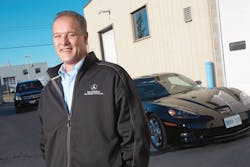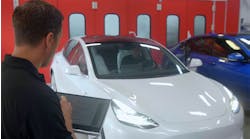What can your shop accomplish in 72 hours? Three years ago, the Ottawa-based body shop at Dow Honda shut down its business, moved to a new location, started spraying waterborne paint, and oh yeah, swapped its Honda affiliation for Mercedes-Benz, which meant starting to repair a whole new category of cars.
It was a Thursday evening in April when Brad Young closed the doors of the body shop and prepared for a busy weekend and a new beginning; the shop was moving to a bigger location across town that would allow it to accommodate more customers and start spraying waterborne paint. Packing had begun weeks earlier. On Friday, everything in the shop—from office supplies to unfinished vehicles—was loaded onto trucks. Saturday and Sunday were long, all-hands-on-deck set-up days, and by Monday, the shop was open for business, with a twist: In addition to the new location and the new paint system, it also shed its Dow Honda name and affiliation. When the doors of the new shop opened on Monday and the first customer drove his damaged car onto the property, it was operating as Star Motors of Ottawa body shop—part of the oldest Mercedes-Benz dealership in the city.
One big change can be a lot for a body shop to handle. Moving to a new location, switching to spraying waterborne paint, or changing dealership affiliations and adding a new manufacturer to the repair repertoire can cost a shop time, mental and emotional energy, and even revenues from lost productivity. But the body shop at Star Motors tackled that trio of changes all at once—and things couldn’t have gone better. The shop, which had sales of $2 million last year, is thriving at the new dealership, thanks in large part to solid planning and essential support from suppliers. Here’s how they did it.
A New Dealership, But Not By Design
Changing the shop name and dealership affiliation wasn’t part of the original plan. In fact, the reason for moving was rooted in square footage. “We moved out of the Honda dealership because we had kind of outgrown the [space],” Young, the body shop manager, explains. “Honda Canada wanted an Express Lube section on-site, and in the property there was no room to expand.”
To solve both problems, the dealership’s owner, Jeff Mierens, bought a building just across the street from the Mercedes-Benz dealership that he also owned, and plans began for the body shop to move into a new home. The space, a former warehouse, had been completely renovated, and a sign with the Dow Honda body shop name had even been installed on the front lawn. But just a couple of weeks before it opened, the shop received some shocking news. “Somebody from another Honda dealership noticed [the sign] and brought it to the attention of Honda Canada,” Young says. “We found out we could not use the Honda name.” Turns out, the new location was in another Honda dealership’s market, and “it was Honda Canada’s suggestion that we not be known as Dow Honda,” Young says.
Talk about an “Oh no!” moment. Suddenly, the very identity of the shop was in flux. But Young looks on the bright side. “Really, if it was going to happen it was better to find out then and not after starting up.” So the new (and nimble) shop opened as Star Motors of Ottawa body shop, and began to specialize in repairing Mercedes-Benz vehicles, as well as Hondas and other makes and models.
Part of the reason for the quickness of the switch was that their owner already owned the Mercedes dealership—which didn’t have a body shop. And Mercedes-Benz gave the shop a grace period on training. (It’s only now, three years after the change, that the shop is working to get certified—a process that will require a roughly $100,000 investment in new equipment, including a new frame machine, and training.)
At the time, none of Young’s employees had experience working on Mercedes-Benz vehicles. And he admits that there was an element of culture shock. “The Mercedes customers have to be dealt with a little differently,” he says. “They just expect a higher level of service. It was a learning curve.”
To help get the techs—who were learning about Mercedes-Benz repair on their own using service manuals—up to speed, Young relied on employees in the dealership’s service department, who “were very helpful,” and hired a body technician with Mercedes experience, Peter McCallum. “Hiring Peter was huge,” Young says.
We were afraid the change in location could hurt us, but I don’t think it ever really did.”
—Brad Young, shop manager, Star Motors of Ottawa
“I had some good information to share with them,” McCallum admits, specifically about taking the cars apart and putting them back together, and some corrosion protection differences. “But I also had to learn a lot about the other vehicles that they were working on. There was a lot of sharing of information.”
It was also a change for customers. Young admits that it was hard to get some of the dealership’s long-standing customers to make the switch to the “new” Star Motors body shop. “A lot of those original customers got used to going elsewhere for body repairs and even when we opened it took awhile to convince some of them to come here,” he says.
Making the Move
Despite the unexpected name and dealership change, the move went according to plan. Because the building was being renovated, architectural details had been in the works for well over a year; more basic work-a-day details like getting Internet and phone service up and running were handled closer to the move-in date. The move itself was done over a long weekend, and the shop lost just one day of business. “It was easier than I expected,” says Young, who attributes that advance planning to the success of the actual, speedy move. (He confesses, in fact, that there was no detailed, step-by-step planning for the weekend activities.)
Good relationships helped make the process painless: The shop’s supplier, the buying group Co-Auto Co-Operative Inc., which had actually owned the building previously, supplied vehicles and extra manpower for the move. Paint supplier BASF removed the old paint from the shop and helped train techs on spraying waterborne. “Rely on your suppliers for all the help, support, and training that you can,” Young advises. “We were really lucky, our suppliers bent over backward for us.” The shop had a unique advantage in that Mierens is also a part owner of Co-Auto. And because Co-Auto owned the building the shop moved into, “once they realized what was going on they were on board [with helping]; we didn’t really have to ask.”
Obviously, that’s not an arrangement every shop can replicate, but Young feels that having a longstanding relationship with a vendor is crucial if you’re planning on asking that vendor for help. “It would be tough to go to someone you don’t deal with exclusively and ask them for help without them asking for something in return,” he says.
So on that first Monday, the shop began operations in a 7,500-square-foot space with brand new equipment—including two Aussen downdraft paint booths, two Devilbiss screw type compressors, a Eurovac vacuum system, a 12,000-pound vehicle hoist and a wall mounted pressure washer—and a new paint system.
The new shop location has other perks in addition to more space and new equipment; namely, parking space for twice as many cars. But there’s a downside to the new space too: It’s separate from the dealership, whereas the old one was connected. As a result, repairs initially took a bit more time because it took longer to go out and find parts in the parts department, Young says. “We just had to plan a little more carefully.”
The shop also had to deal with the expected questions from customers and insurance companies that can come with a new name and location. “There was a little confusion at first,” Young says. “People didn't always make the connection between the [old shop name and new shop name].” To help assuage that confusion, Young and his nine employees “called as many people in the insurance business as we could think of” and had signs at both dealerships. But for the most part, marketing the new shop was done by word of mouth.
“It was exciting and a little intimidating too,” Young says. “We were afraid the change in location could hurt us, but I don’t think it ever really did.” Indeed, the shop’s revenues have jumped from a high of $1.5 million in the old location to $2 million now.
Switching from Solvent
Once in the new shop, Young’s employees faced not only the challenge of learning to repair Mercedes-Benz vehicles, but also learning to spray waterborne paint. “Our owner is eco-minded,” Young says of the impetus to make the switch.
BASF, the shop’s paint supplier, helped train paint techs on the new technique. “BASF and our distribution partner Co-Auto wanted to make this as easy, and as seamless as possible for Star Motors,” says Will Clarke, technical service representative for BASF. “A synergistic partnership with your vendor helps the supplier feel comfortable—and it keeps everyone on the same page, from what equipment to buy [to] the training that is taking place with the techs and employees.” Says Young: “They were here working with us, they rolled up their sleeves and got dirty like the rest of us.” The result, he adds, is that “we jumped in at the deep end, and had very little in the way of re-dos.”
Like many shops that have made the switch to waterborne paint, Star Motors has seen a positive impact on the bottom line. Young estimates that the shop is saving $500 to $600 a month on thinner alone. Expenses are down, and waste has been reduced.
And with that change already made, the shop’s biggest challenge in the days ahead is making sure there’s enough work. Collision repair business has slowed down as much as 20 to 30 percent in Canada, Young says, and while he doesn’t expect his revenues to drop, he also doesn’t expect them to increase. To keep even, he’s mailing out flyers and trying to get more DRPs (the shop currently has three) by knocking on a lot of doors. Having more than one dealership feeding them customers helps too.
That’s just one unexpected benefit of those big changes. “I think it’s been good, not just for us but for the Honda dealership, too,” Young says. “They gained the Express Lube that Honda Canada wanted us to have, the Mercedes dealership gained a body shop, and we gained more room, a better facility and more parking.”



